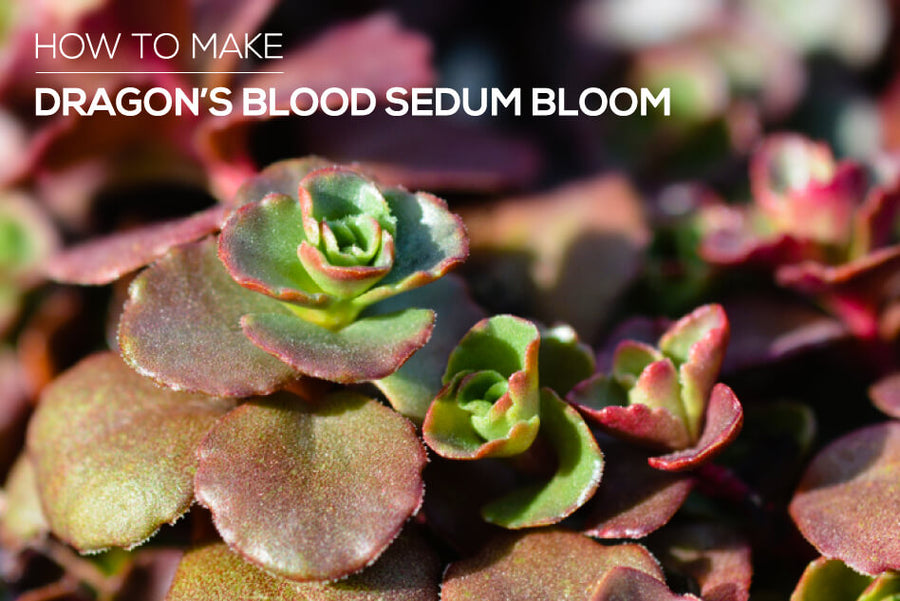Schorbuser Blut, the original German term for Dragon’s Blood is developed from S. spurium Coccineum and is hailed as one of the all-time favorite varieties of creeping stonecrop.
In early summer, Dragon’s Blood leaves turn dark green with a layered burgundy look over the edges. In late summer, however, you can notice that the succulents starts to turn red. And by the end of the fall, Dragon Blood transforms from a bright green color to deep red.
Despite not the mail goal, many growers consider getting Dragon Blood sedum to bloom an added bonus. Witnessing these cluster of lovely flowers blooming can often be a pretty rewarding experience.
Preparing your succulent to bloom
How can you make your Dragon Blood bloom? First of all, not all succulents bloom. Some might take years to bloom and some die after blooming. Dragon Blood Serum's flowering season starts from August to September. Their flower is naturally star-shaped and pink, but some varieties can have white or dark red colors. Here are some tips to make your plant blooms.
Watering
Sedum Dragon Blood Succulent | Click here to purchase
Generally speaking, succulents are water-filled plants so they do not need frequent watering. Sedums like Dragon Blood require well-drained soil and tolerate dry conditions well. Make sure that your soil mix is at least half an inch dry before adding more water.
If you suspect that your sedum is not doing well because it is overwatered, take it out from the soil and let it air dry for a few days and repot it with well-drained soil. There are several ways to increase your soil drainage whether you grow Dragon Blood as ground cover or in a container.
Plenty of light
Place the plant where it will get full sun. Without enough light, sedum will produce few or no blooms. Dragon Blood needs at least 6 hours of sunlight or more to thrive. Place it in south or east facing windows indoors to ensure adequate lighting. If you're growing it indoor without much natural light, consider using grow lights. 6500K Fluorescent lights are recommended since they resemble natural light the most but if you want your succulents to bloom, a color light of 3000K might be better.
Fertilizer
Producing flowers require a lot of energy so feeding your succulents some extra nutrients will help supplement their needs during flowering season
For most flower gardeners, a balanced fertilizer containing three following major ingredients is important to supplement their plant growth.
- Nitrogen (N): Promotes healthy foliage
- Phosphorus or Phosphate (P): Stimulate root system
- Potassium or Potash (K): Aids in flower (and fruit) formation
Flower fertilizers usually have a larger percentage of phosphorus compared to other ingredients. Healthy flowers start with vigorous root systems, and a phosphate boost can ensure your flowers get a good start.
Fertilizers are better applied at a quarter or half strength, about every two weeks. Refrain from fertilizing towards the end of fall season and during winter months.
More preparation
Sedum Spurium Dragon's Blood Stonecrop | Click here to purchase
In addition to paying attention to watering routine, sun exposure and soil condition, there are something you can do to increase the chance your Dragon Blood bloom.
- Remove dead stalks of the sedum in early spring, using sharp pruning shears, to initiate healthy new growth.
- Pinch taller varieties of sedum back by one-half of their height in early summer, if desired. Snip in a spot just above where leaves meet the stem, using sharp shears or your finger and thumbnail. Pinching back the plant promotes smaller, more numerous flowers and also helps prevent older, denser plants from splitting in the middle as they become top-heavy with bloom.
How Long Should it Take for Dragon’s Blood Sedum to Bloom?
Dragon’s Blood can grow as tall as 12-inches tall and 12-18 –inches wide. Though it’s compatibility to grow practically anywhere makes it more attractive for an outdoor garden. Besides, Dragon’s Blood is resistant enough against pests, deer, or rabbit disease. And it’s no wonder everyone is more curious than ever to find out the method of cultivation and period of time it takes to bloom.
Also, the plant is not susceptible to low maintenance and doesn’t require your 24/7 attention. It all comes down to the time span to disseminate the division process and stem cutting of the plants. Start out by early summer and by the end of the winter; you will have Dragon’s Blood sprouting in your garden.
You might take a sigh of relief in knowing the fact that Dragon’s Blood can endure the coldest and harshest winter seasons. Despite the chill of the cold season, it will end up blooming with more glimmer and size every year.
See more about How to care for Sedum Donkey's Tail
Click here to get all the details.
If you found this article interesting,
And get a free plant when your friends make an order. Sign up here!
Learn more about how to nurture and enjoy many gorgeous succulents and clever decoration tips with our newsletter. Let's sign up!
Recommended Items


































































































